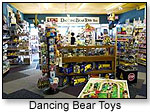
April 20, 2024


| With larger orders, "you tend to get free freight or longer paying terms.” — Erika Evers, Dancing Bear Toys |
 Establish a Track Record. Before opening a second store, make sure your first is "comfortably in the black," with a history that allows for reliable sales predictions, Zeigenhagen said. "A store needs about three years to establish a track record, to ensure that the decision was a sound one and there's a synergy between the store and the community it serves."
Establish a Track Record. Before opening a second store, make sure your first is "comfortably in the black," with a history that allows for reliable sales predictions, Zeigenhagen said. "A store needs about three years to establish a track record, to ensure that the decision was a sound one and there's a synergy between the store and the community it serves." Maintain Cash Flow. If you decide to utilize another location, provide a large enough cash reserve for the first store to subsidize the second while business is growing, Nick said.
Maintain Cash Flow. If you decide to utilize another location, provide a large enough cash reserve for the first store to subsidize the second while business is growing, Nick said. Staff for Success. The decision to open a second store depends on having the right people to help you do it, Evers said. Her family has high expectations of staff, she added, but retaining good employees can be challenging.
Staff for Success. The decision to open a second store depends on having the right people to help you do it, Evers said. Her family has high expectations of staff, she added, but retaining good employees can be challenging.
Copyright © 2024 TDmonthly®, a division of TOYDIRECTORY.com®,
Inc.